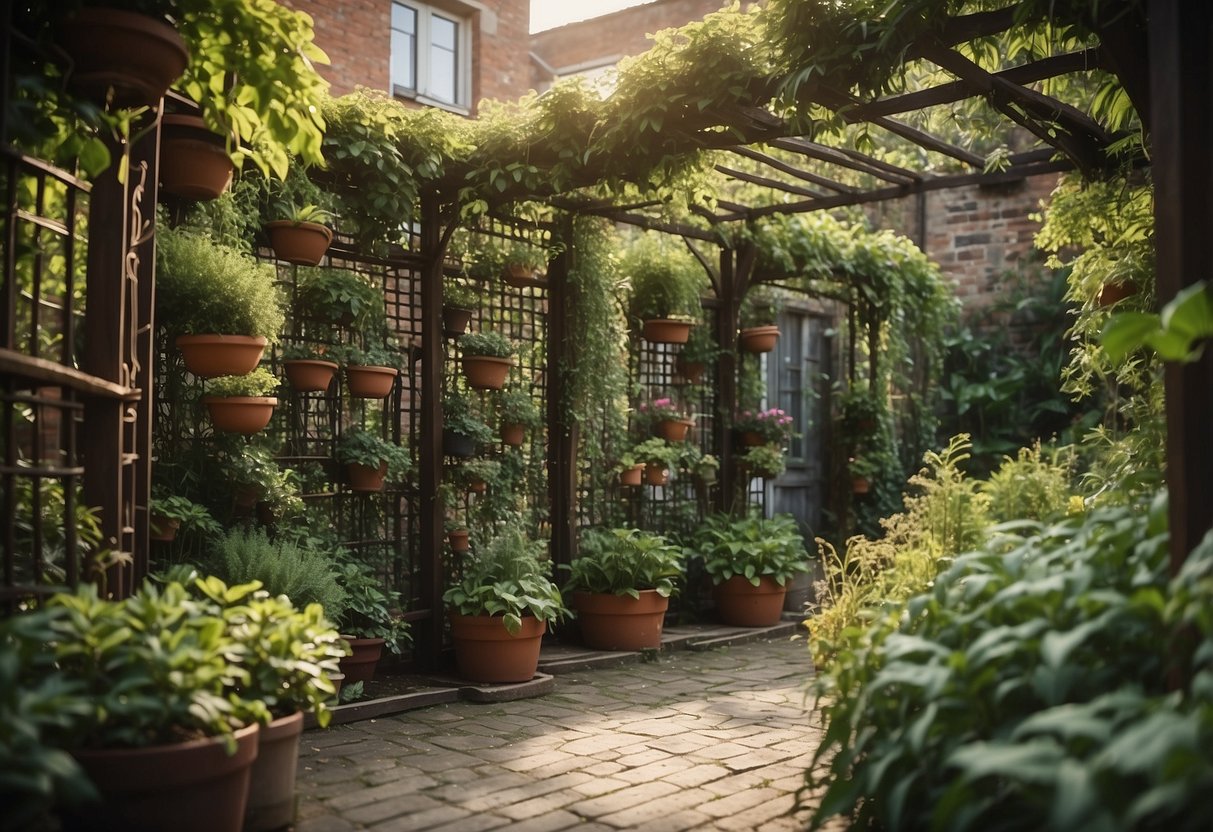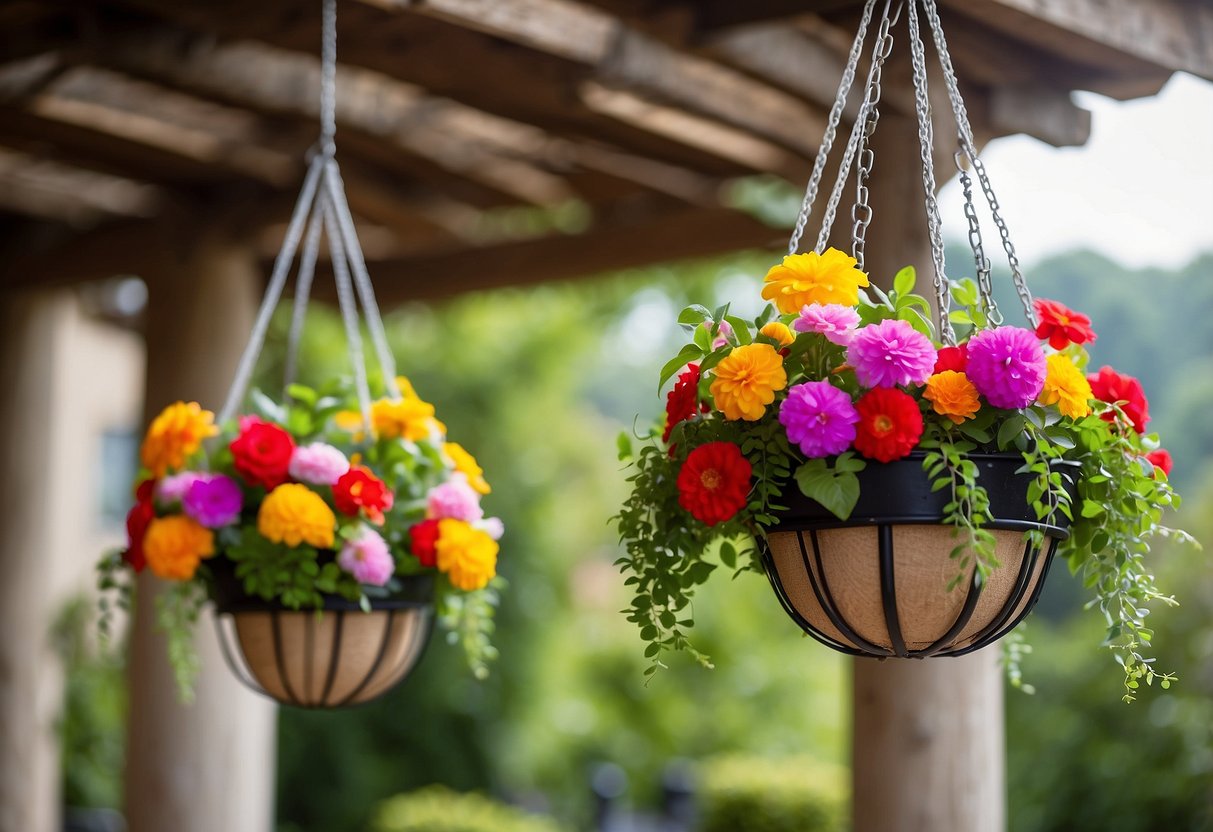Garden Ideas for Hanging Plants: Stylish Tips and Inspirations
Adding hanging plants to your garden can transform any space into a lush, green paradise. These plants not only maximize your gardening area but also bring a touch of nature to balconies, patios, or even indoor spaces. From small apartments to expansive backyards, hanging plants offer a versatile solution to brighten and enliven your surroundings.

Wondering how to elevate your space with hanging plants? There are numerous creative and practical ways to display these beautiful plants to match your style and needs. Whether you’re an experienced gardener or a novice looking to try something new, incorporating hanging plants into your garden design can be both fun and rewarding.
1) Macrame Plant Hangers

Macrame plant hangers add a touch of elegance to any garden. They are great for small spaces, offering a stylish way to display your plants.
These hangers are easy to make with just a few materials. You need some strong cord, a pair of scissors, and a small plant pot.
For beginners, you can start with simple patterns and basic knots. With a bit of practice, you can try more complex designs, like two-tier hangers.
2) Hanging Lantern Planters

Hanging lantern planters are a unique way to add charm to your garden. You can take an old lantern, remove the glass panels, and fill it with soil and flowers. The result is enchanting and gives your space a whimsical touch.
For more creative ideas, you can find inspiration on DIY hanging planter ideas. Let your garden glow with these delightful planters!
3) Vertical Wall Planters

Vertical wall planters are a fantastic way to use small spaces for gardening. You can attach planter boxes to a wall or fence to create a stunning display.
Plants like succulents or herbs work well in these setups. For a creative twist, you can use colorful planters or different shapes to make the garden pop.
This method is great for both indoors and outdoors, giving you the flexibility to bring some green into any area. Check out some unique DIY vertical garden ideas for more inspiration!
4) Tiered Hanging Baskets

Tiered hanging baskets are a great way to add depth and dimension to your garden. They allow you to grow multiple plants in a vertical space. You can mix and match different plants to create a vibrant display.
Use different sizes of baskets to create a cascading effect. This creates a visually interesting look in your garden. Choose plants with varying colors and textures for the best effect.
For a modern touch, consider using interesting foliage plants. Find inspiration from a variety of hanging basket ideas to elevate your garden design.
5) Upcycled Bottle Garden

Using old plastic bottles for gardening is not just eco-friendly but also fun and creative.
You can create a vertical bottle garden by hanging bottles on a wall or fence. Simply cut open the side, fill them with soil, and plant your favorite herbs or flowers.
Another idea is to build a bottle tower garden for veggies or succulents. Stack bottles on top of each other, making sure each one has drainage holes. This saves space and gives your garden a unique look.
6) Indoor Herb Planter Set

Using an indoor herb planter set can make growing fresh herbs easy and fun. You can place it on your kitchen counter or windowsill. Choose herbs like parsley, basil, or mint for a constant supply.
Many planter sets come with everything you need. Just add water and watch your herbs grow. This idea is perfect for small spaces.
7) Geometric Metal Hangers

You can add a modern touch to your garden with geometric metal hangers. They come in various shapes like hexagons, triangles, and circles.
These hangers not only look sleek but are also sturdy. They can support both small and medium-sized pots.
Check out this selection for unique or custom, handmade pieces.
8) Woven Basket Planters

Woven basket planters add a rustic and charming touch to your garden. They are perfect for hanging plants and provide good air circulation for the roots.
You can find a variety of woven hanging plant baskets on online marketplaces. These baskets come in different sizes and designs to fit your style.
For a DIY approach, you can use an old fruit basket and weave it yourself. This can make for a unique and personal addition to your garden.
9) Small Wooden Swing Planters

Small wooden swing planters add charm and a touch of whimsy to your garden. They can be hung from tree branches, pergolas, or even balcony railings. Ideal for small plants like succulents or herbs, these planters make any space feel cozy.
You can easily create these swing planters using reclaimed wood and some sturdy rope. They are perfect for DIY enthusiasts looking for a weekend project. Adjust the height and arrangement to suit your garden’s layout and enjoy the playful addition to your outdoor space.
10) Hanging Moss Balls

Hanging moss balls, or kokedama, are a fun and simple way to add greenery to your space. These little plant balls are made from a mix of bonsai soil, peat moss, and wrapped in sphagnum moss. They can be hung with string or twine.
You can create your own by mixing peat moss and bonsai soil together. Once you have your soil ball, wrap the roots of your chosen plant in damp sphagnum moss before inserting it into the soil ball. Finish with sheet moss and secure with string.
Plants like small succulents or beginner houseplants work great for kokedama. Keeping them misted will help them stay healthy. For more detailed instructions, check out these resources on DIY kokedama and best plants for kokedama. Happy gardening!
Choosing the Right Plants

When picking hanging plants for your garden, consider the type of plants that thrive well in hanging containers and the key factors to keep in mind for their care.
Best Types of Hanging Plants
Pothos and Spider Plants are popular choices for hanging plants. Pothos can tolerate different light levels and only need watering when the soil is dry. Ferns are another great option for hanging pots due to their lush, cascading fronds and preference for indirect light. String of Pearls is perfect for adding a unique touch with its bead-like leaves, needing minimal watering as it stores water in its leaves.
Boston Ferns and English Ivy are also excellent. They grow quickly and add thick foliage to your space. These plants benefit from regular misting to maintain humidity. If you want flowers, Fuchsias are a lovely choice, providing vibrant blooms throughout the growing season.
Factors to Consider
Think about the light conditions in your space. Plants like Pothos and Spider Plants do well in lower light, while others, like Fuchsias, need bright, indirect light.
Watering needs are crucial. Some plants require frequent watering, like Ferns, while others, like the String of Pearls, need less water due to their succulent nature. Ensure your hanging containers have good drainage to prevent root rot.
Consider the growth habit of the plants. Trailing plants like Ivy and Pothos look attractive in hanging baskets as they cascade down beautifully. Also, the weight of the plants and the strength of the hanging structures are important for safe and healthy growth.
Aim for a balance between aesthetics and practical needs to ensure a thriving hanging garden.
Installation and Maintenance

When setting up a hanging garden, ensure you use the correct hanging techniques and understand how to properly water and feed your plants. This will keep your hanging plants healthy and vibrant.
Proper Hanging Techniques
Choose the right hooks or brackets based on the weight of your plants.
Screw-in hooks work well for lighter plants. For heavier plants, wall brackets offer better support. Use a stud finder to ensure you’re anchoring into a solid part of the wall or ceiling.
Materials you might need:
- Stud finder
- Drill
- Screws or hooks
- Wall anchors (for plaster/drywall)
Steps:
- Locate a stud using the stud finder.
- Mark the spot where you want the hook or bracket.
- Drill a pilot hole.
- Install the hook or bracket firmly.
If you’re using rope or chain, make sure they are strong enough to support the weight of the plant, soil, and pot.
Tip: Check all parts of the installation regularly to ensure nothing is loosening over time.
Watering and Feeding Instructions
Hanging plants often dry out faster than ground plants.
Watering Tips:
- Water when the top inch of soil feels dry.
- Use a watering can or a cup to control the amount and avoid splashing.
- Allow water to drain out completely to prevent root rot.
Feeding Tips:
- Use a balanced liquid fertilizer every 2-4 weeks during the growing season.
- Dilute the fertilizer to half-strength to avoid burning the roots.
Common Issues:
- Yellowing leaves: Could indicate overwatering or nutrient deficiency.
- Wilting plants: Often a sign of underwatering.
Keep an eye on how much sunlight your plants are getting. Some may need more shade or additional light depending on their needs. Adjust watering and feeding based on how your plants respond to their environment.
By paying attention to these details, your hanging garden will thrive and bring beauty to your space.







